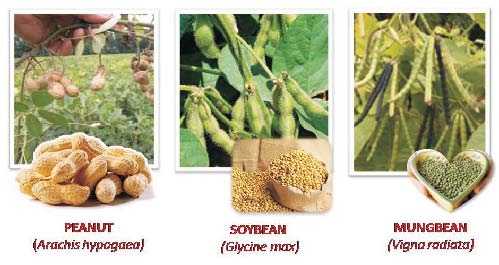While cereals such as rice and corn are the staple food in Asia, legumes are increasing in importance as sources of nutrition for both humans and the soil. With the growing demand for food, especially rice and corn, farmers are prone to resort to monocropping, a farming practice which not only favors pest infestation and soil degradation but also reduces the opportunity to generate better incomes.

When the rice-rice or corn-corn cropping pattern becomes the norm, humans, particularly those in the distant areas or those with much reduced purchasing power, may miss out on other essential and inexpensive sources of protein, vitamins, and minerals with a largely rice or corn diet. Hence, crop diversification is an attractive option that wise farmers could take advantage of given its several benefits.
Ms. Rose Mary Aquino, a senior researcher at the Cagayan Valley Integrated Agricultural Research Center (CVIARC), is one staunch advocate of crop diversification. Specifically, she actively promotes grain legumes, such as groundnut (peanut), mungbean, and soybean, as a means to alleviate poverty in the face of climate change and malnutrition in marginalized rice- and corn-based farming communities.
During the 7th National Agriculture and Fisheries Technology Forum and Product Exhibition organized by the Bureau of Agricultural Research (BAR) at the SM Mega Trade Hall 2, SM Mega Mall, Mandaluyong City on 11-14 August 2011, Aquino presented the enhancement of grain legumes productivity in predominantly rice and corn producing areas in Region 2.
Breaking the monocrop
Based on the studies made by CVIARC researchers from 2006-2010, Aquino presented the four possible cropping patterns for a cereals-legumes cropping system. For example, it is possible to adopt a rice-mungbean, corn-soybean, corn-peanut, or corn-mungbean-peanut intercrop depending on the average monthly rainfall and temperature.
“Grain legumes production supports the agriculture sector’s climate-change mitigation measures in three ways: it requires minimum or zero tillage, it retains adequate levels of crop residues to protect the soil from erosion, and intercropping reduces pest and disease incidence,” explained Aquino.
Groundnut: A+ in nutrition
In her presentation, Aquino presented groundnut or peanut as the legume that could be graded A+ in nutrition for its low salt but high protein content, energy value, and dietary fiber. She presented data showing that groundnut contains unsaturated fat – the good fat – that helps to remove cholesterol from the blood. Likewise, it contains more protein than eggs, dairy products, and various cuts of meat and fish. As a source of dietary fiber, it also reduces the risk of having some types of cancer and controls blood sugar levels.
“Of the 13 vitamins needed by the body, half of it is present in groundnut. Moreover, of the 20 minerals necessary for normal body growth, seven can be found in groundnut” she added.
According to Aquino, the current climate change-ready varieties of groundnut are NSIC Pn 11 or Namnama-1, NSIC Pn 14 or Namnama-2, and NSIC Pn 15 or Asha. As the overall coordinating agency for agriculture and fisheries R&D, BAR has funded the adaptability trials and promotion of these promising peanut varieties, tapping CVIARC as one of the research proponents.
“The market potential of groundnut is great particularly in our country that imports 30,000 to 50,000 tons annually which is more than 50 percent of our national requirement. The demand of peanut processors in our country is at 343 metric tons monthly in the shelled form which sells at P50 to P60 per kilogram. In unshelled form, the farm gate price of peanut is ranges from P25 to P28 per kilogram,” said Aquino.
“We have submitted samples of these promising peanut varieties to five major processors in Manila and they all gave positive feedback mainly due to their improved shells and bigger nut size,” she added.
Mung bean: The black gold
If you used to think twice about eating mung bean, you’d be better off thinking twice about not getting the rich protein and minerals that can be found in it. After all, it is not called ‘black gold’ for nothing.
“Mung bean sprouts are rich in Vitamin C and iron. Iron in mung bean sprouts is twelve-fold high as compared to mung bean soup while a four-fold increase in iron can be achieved when it is cooked with tomato,” said Aquino in her presentation.
Like groundnut, mung bean is a drought-tolerant, all-season crop that matures from 55 days to 74 days after emergence (DAE) depending on the variety planted. The climate change-ready varieties for mung bean are Pagasa 7, NSIC Mg 12 or Pagasa 19, and NSIC Mg 15 or Kinang.
According to Aquino, mung bean’s high carbohydrate content particularly found in Pagasa 19 makes it a good raw material for bread or noodle production.
“The Pagasa 7 mung bean is sold at farm gate price of P35 per kilogram. In terms of rat and frog infestation, Pagasa 19 is at an advantage because the plant grows taller. On the other hand, Kinang is a good choice if you want your plant to mature early,” she explained.
Soybean: The wonder crop
Soybean, while currently classified as legume in the country and in other parts of the world, the Food and Agriculture Organization (FAO) and the United States Department of Agriculture (USDA) classify this crop as an oilseed. Whether touted as the “king of beans” or “wonder crop”, the powerhouse of health benefits that is present in soybeans is worth paying attention to.
Aquino discussed soybean as a source of high quality protein and has numerous health benefits that can be gained from soy isoflavones including the ability to lower the risk of several types of cancer, reduce menopausal symptoms such as hot flushes in women, and reduce the risk of osteoporosis and heart disease.
“The tocopherol or Vitamin E found in soy is a very good anti-oxidant. Soybean sprouts also contain 12 times more iron than found in mung bean,” she added.
While the US remains the biggest producer of soybeans in the world, the Philippines is beginning to dip into the global opportunities for soybean. Through the Philippine Soybean Roadmap 2011-2014 crafted by the Department of Agriculture (DA), BAR is tasked to coordinate all R&D activities needed to be undertaken for the roadmap to take off. BAR, in coordination with regional research centers such as CVIARC, is looking into the potential to supply the huge soy demand in the Japanese market. Currently, the approved varieties for soybean are PSB Sy 2 or Tiwala 6 which matures in 86 to 103 DAE.
Soil health and organic agriculture
The soil also deserves justice- if only they could have their own lawyers. Thus was the lament of Aquino about the severe problem on land degradation due to wrong farming practices. Thankfully, even with increasing cropping intensity, soil health can be maintained with the inclusion of grain legumes in the production system.
“Peanut, mung bean, and soybean are nitrogen-fixing crops because of Rhizobium, the bacteria that can be found abundantly in the root nodules of legumes,” said Aquino.The nitrogen compounds that can be found in legumes are essential for the growth of plants. When the plant dies, the nitrogen that is fixed is released to other plants and also helps to fertilize the soil. Aquino said that legumes maintain soil fertility by serving as ‘green manure’ and soil conditioner, and acts as a good substrate for organic fertilizer production.
According to Aquino, due to this nitrogen-fixing ability, the organic way of legumes production is highly possible and commendable.
“Legumes are very responsive to residual nutrient utilization and require less fertilizer input. In Cagayan Valley, the farmers who adopted a peanut-white corn intercrop did not apply chemical fertilizers or pesticides. Farmers who organically planted mungbean and soybean after upland rice also found that on-time planting helped minimize pest damage,” said Aquino.
Development of a legume industry
A 2006 study from Central Luzon State University (CLSU) by Abon, et al. assessed the legumes industry and the current policy environment to help boost the industry. An inventory of government policies and programs were undertaken that included the enabling institutions and their outcomes. The researchers highly recommended an appropriate policy environment that will establish a national program for sustained legumes production with provisions for adequate R&D support on its production, processing, and utilization. Improvements on government credit-marketing support services that will promote productivity, link, and expand markets were also deemed necessary. Furthermore, the development of a stronger linkage between producers and processors of legumes and the enabling mechanisms for the establishment of rural-based legumes enterprises with the government providing market and price incentives were recommended.
With the bright promise of legumes and the existence of government support particularly from the DA including BAR, dedicated researchers and scientists, farmers’ interest, and increasing public awareness in nutritious and organic food, the aim of producing quality source of food and sustainable livelihood is an exciting prospect that, hopefully, this generation would not miss out this time.
———–
For more information on legumes, you may contact Ms. Rose Mary Aquino or CVIARC at tel. no. (078) 622-0961 to 62, email: rosegaquino@yahoo.com, cviarc_ies@yahoo.com.
Source: Miko Jazmine J. Mojica, Bar Chronicle August 2011 Issue (Vol. 12 No. 8)




Recent Comments